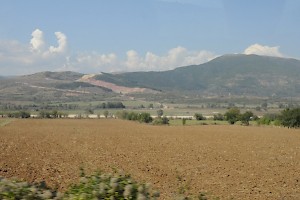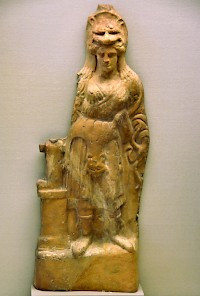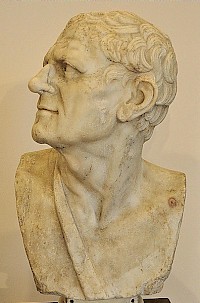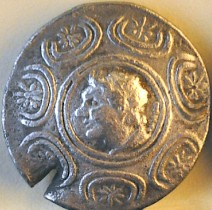Paeones
Paeones (Greek Παίονες) or Paeonians: mixed Thracian-Illyrian nation, living on the banks of the upper reaches of the rivers Axius and Strymon.
Country

In several fragments of an incomplete part of his Geography, the Graeco-Roman geographer Strabo describes the country of the Paeones. They are living to the north of the Macedonians and to the west of the Thracians; with the latter, the Strymon is the border, although this river has its sources in Paeonia. The river Axius - both banks are inhabited by the Paeones - flows from Paeonia to Macedonia, but the road along this river is difficult and comparable to Tempe. Strabo also mentions the Autariatae, Dardanii, and Ardiaei as the neighbors of the Paeones and mentions a town called Abydon.note
The difficult road must be the Iron Gate (Demir Kapija) in the southeast of today's republic of Macedonia. Abydon is also mentioned by Homer.note The Athenian historian Thucydides also suggests that the Strymon was the boundary between the Paeones and the Thracians.note Other authors record stories that suggest that Paeonia once extended to the Thermaic Gulfnote and the general impression from the history of the Paeones is that these people lost terrain to the Macedonians and Thracians, who encroached upon their territory from the southwest and southeast.
In his Histories, the Greek researcher Herodotus of Halicarnassus tells us that there were several Paeonian tribes: the Paeoplae and the Siriopaeones surrendered to the Persian king Darius,note the Doberes lived on the banks of Lake Prasias,note which is in the Strymon valley. A corrupt line seems to suggest that Lake Prasias was also the place where the Agrianes lived,note while Strabo places them at the sources of the Strymon.note
This inconsistency is unsurprising. These authors were writing on various moments; not all writers had visited Paeonia; the tribal formations on the southern Balkan Peninsula were fluid; errors are always possible. For example, Plutarch confuses Paeones and Pannoniansnote and was corrected by Cassius Dio.note
Origin
Homer, whose knowledge of the southern Balkan Peninsula is patchy, presents the Paeones as allies of the Trojans,note which probably only means that he recognized them as non-Greek; otherwise, he would have introduced them in Agamemnon’s Panhellenic army. He places the Paeones near the Axius,note but appears to have known little more, because he gives the Paeonian leaders the fantastic, Greek names Asteropaeus and Pyraechmes (“lightning” and “fiery spear”).note
Picking up a clue from Homer, Herodotus describes the Paeones as descendants of the Trojans.note Strabo may be closer to the truth when he presents the Paeones as Phrygians,note although he suggests that they were Phrygians who moved to Europe, whereas there is evidence for a Phrygian migration from the southern Balkan Peninsula to Asia in the early Iron Age.

The Paeones shared several traits with their eastern neighbors, like the cult of Dionysus (which the Paeones called Dyalus) and a goddess which Herodotus calls Queen Artemis and is the Bendis of the Thracians.note We know a couple of Paeonian words: for example, the author known as Pseudo-Aristotle tells that the Paeones called the bison monaepus.note These words can be interpreted as Thracian and Illyrian. The Iliad mentions a Paeonian warrior with a Thracian sword,note while Strabo refers to the Paeones as Thracians.note
Although all this suggests that the Paeones were Thracians, it must be stressed that Herodotus and Thucydides distinguish the Paeones from their eastern neighbors.note Perhaps it is better to consider the Paeones as a nation with various Thracian, Macedonian, and Illyrian traits.
Archaic and Classical Age
The Paeones make their appearance in history as the adversaries of the Perinthians in a war that happened, according to Herodotus, long time ago.note The fact that the battle started with duels (and not as a hoplite fight) suggests that it was indeed not long after Perinthus had been founded, which happened in 599 BCE. The interesting fact is that Herodotus presents the Paeones so far to the east, near the Hellespont. This suggests again that originally, the Paeonian country was larger than the valley of the Upper Axius to which the Paeones would eventually retreat.
In c.512 BCE, the Persian general Megabazus subdued those Paeones who were living at the Lower Strymon.note He deported two groups, the Paeoplae and the Siriopaeones, to Phrygia.note During the Ionian Revolt (499-494), they saw an opportunity to return, with some help from the Greeks of Chios and Lesbos, and may have settled more upstream, outside the Persian zone of influence.note
Persian control of the southern Balkan Peninsula increased after Mardonius’ expedition to Macedonia in 492 BCE and we may assume that several groups of Paeones became subjects of the Great King. In 480 BCE, they are mentioned as soldiers in the army of king Xerxes.note
After these events, the Paeones disappear from sight for more than a century. There is only one reference to them: according to Thucydides, Sitalces, who was king of the Thracian Odryssae from 431 to 424, controlled the Agrianes, one of the Paeonian tribes, but this must have been temporary.note We may assume that the Paeones managed to remain independent from the Thracians and the Macedonians, living along the upper reaches of the Axius and Strymon, far from the Aegean shores they had once controlled.
Fourth Century

We learn about the Paeones again in the age of king Philip, the man who reorganized Macedonia as a powerful state and was seriously interested in the north. As it happens, the Graeco-Roman historian Diodorus of Sicily offers a lot of information, which he summarizes from the History of Philip of Theopompus, a contemporary of Philip.
Philip succeeded to the throne in 360 BCE after a series of disasters, which had weakened his kingdom and had allowed the Paeones to pillage the Macedonian territories.note Initially, Philip paid the Paeonian leaders to leave,note but when their leader Agis died in the winter of 359/358, he immediately attacked, defeated, and subdued them.note A Paeonian attempt to regain independence by concluding an alliance with the Thracian and Illyrian opponents of Macedonia failed: Philip learned about it and had defeated his enemies before their armies could unite.note (For this victory, Plutarch gives credit to Philip's right-hand man Parmenio.note)
During the reign of Philip’s son Alexander (r.336-323), we find the Paeones as horsemen,note commanded by a prince named Ariston.note This unit appears to have been sent back after the battle of Gaugamela, or may have been annihilated during that fight, because there is no reference to it after 331 BCE. Another unit, the Agrianes, remained with Alexander. These soldiers fought as light infantry.
Hellenistic Age

During Alexander’s Asian campaign, his European possessions were governed by Antipater. After the death of Alexander in 323 BCE, Antipater remained in charge and was succeeded in 319 by his son Cassander. He supported the Paeonian leader Audoleon against the Autariatae.note
From his coins, we can deduce that this Audoleon accepted the royal title in 306, when several successors of Alexander did the same (Antigonus and Demetrius in Asia, Ptolemy in Egypt, Lysimachus in Thrace). Audoleon was certainly well-respected; his daughter was one of the wives of Pyrrhus, king of Epirus (r.306-372).note
The inaugurating rite of the Paeonian kings consisted of taking a ritual bath in a river named Astibus or Arisbus.note When Audoleon's son Ariston succeeded his father and had taken his bath, he proceeded to have dinner, but was taken captive by Lysimachus, the king of Thrace, who added Paeonia to his territoriesnote and obtained the royal treasure that had been buried in a river.note This must have represented a considerable wealth, because "people who plough the Paeonian land find nuggets of gold".note
In 288, Lysimachus expanded his power to Macedonia, but he was defeated several years later by Seleucus I Nicator, the king of the Asian parts of the former empire of Alexander, in the battle of Corupedium (281). When Seleucus wanted to add Lysimachus’ kingdom to his own possessions, he was killed by Ptolemy Keraunos, who would never consolidate his power because in 279, a new enemy arrived on the scene: the Galatians. Having invaded Paeonia,note these Celtic migrants proceeded through Macedonia to Greece.note It seems that at least some Paeones joined the invaders when they moved on to Asia, because an inscription from Tlos in Pisidia mentions them as allies of the Galatians, defeated by one Neoptolemus.

The Paeones were reorganized by king Dropion, who created a Paeonian League and broadcasted his independence by sending presents to the oracle of Delphi.note The independence did not very long, because king Antigonus II Gonatas (r.283-239) subdued the Paeones in 249. To keep control, he build a city, which he called Antigonia on the Axius and is identical to modern Negotino.note
The Coming of Rome
Now subject to Macedonia, the Paeones fought for Antigonus’ grandson and successor Philip V (r.221-179) against the Romans in the Second Macedonian War (200-197). Later, they would join the Macedonian king Perseus (r.179-168) in his war against Rome.note
After they had won this Third Macedonian War, the Romans divided Macedonia into four republics. Because the river Axius was the border between the second and third republics, Paeonia was divided.note After the Fourth Macedonian War (150-148), the Paeonian towns became part of the newly created Roman province of Macedonia.